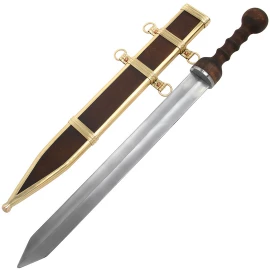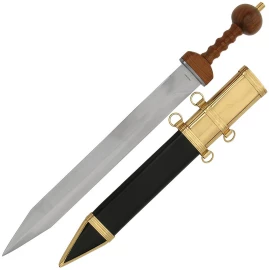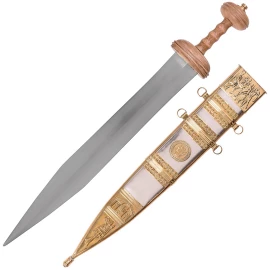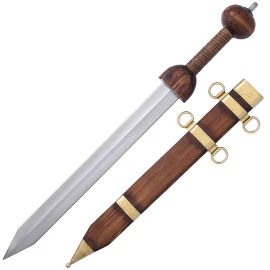Gladius – roman short sword

Battle tactics
Common roman legionary was armed with a rectangular shield Scutum, a short sword Gladius, a javelin Pilum (or could be a pair of pila) and often a dagger Pugio. The units created powerful formations while the soldiers were hidden behind the wall of the shields. Usually they attacked their enemy with a rain of javelins followed by the close combat with the swords. Gladius enabled all - cutting, chopping or thrusting strikes.
The thrusts were short and quick - just a few centimetres into an opponent’s body and were performed by the first row of rectangular formation. After 20 minutes the soldiers switched their positions and another fresh row come to fight. The heaviest assault of this dreadful machinery was usually aimed at the centre of enemy’s army. After its capitulation the other parts remained divided and so much easier to defeat.
Variations and their descriptions
Gladius is similar to ancient Greek sword and was probably derived from it. There are several variations of this sword as it was evolving. Following four types are the most common:

- Gladius hispaniensis – classic sword from the republic era with a typical leaf shaped double edged blade and a wooden hilt (or sometimes, for top level officers, made from ivory). This gladius originally came from present Spain. Its length of 75-85 cm, blade width 5 cm and weight about 1 kg is making it the largest and heaviest type. Later it was replaced by modern lighter swords such as Mainz or Fulham.
- Mainz gladius – most probably developed in border town Moguntiacum (present Mainz, Germany). Unlike the previous one this blade had straight edges and it is recognizable by its long tip. This feature allowed piercing thrust even through enemy’s armour. On the other hand this kind of blade could easily break. The main dimensions were: sword length 65 – 70 cm, blade length 50 – 55 cm, blade width cca 7 cm, weight 800 g.
- Pompeii gladius – next generation of gladius is called after the famous town located under Mt. Vesuvius volcano because it was discovered in its ruins. The blade’s tip was significantly shorter and more robust which eliminated the flaw of “Mainz” and made the sword more effective. This type was the most popular among the soldiers. It was also the shortest. Double edged blade was 45 – 50 cm long and 5 cm width. The entire weapon’s length was up to 70 cm. Pompeii and Mainz versions were both used simultaneously for centuries. In the empire era was also introduced similar but longer swords called spatha and semispatha.
- Fulham gladius – this type was found in Britain and it is possibly a link between Mainz and Pompeii. It really resembles Mainz with shape and dimensions but has narrower blade (cca 6 cm) and triangle shaped tip like Pompeii.
Carrying
Roman soldiers were carrying their practical swords different ways in different times. In republic era they had sheathed sword attached to a belt as well as their dagger. Then for some time they used two belts. Finally in late 1st century AD they switched to a shoulder strap with gladius mounted on it to be drawn from behind the back. It is not exactly clear on which shoulder they were carrying it but it is known that centurions (professional officers) had it on the other side than common soldiers.
Anyway, the sword definitely had to be held in the right hand. If some soldier was left handed he was trained with his left hand tied behind his back until he began to fight with his right hand. In the battle soldiers carried this weapon ready by their right side with exception again for centurions (left side).





Comments